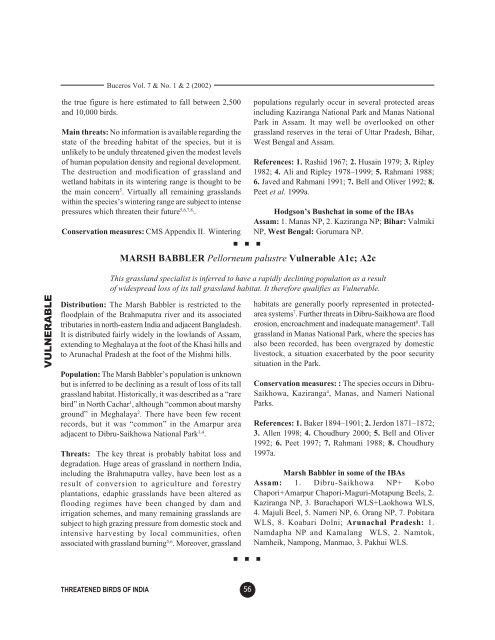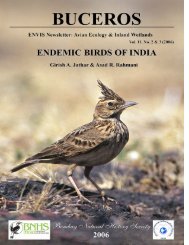Untitled - ENVIS Centre on Avian Ecology
Untitled - ENVIS Centre on Avian Ecology
Untitled - ENVIS Centre on Avian Ecology
Create successful ePaper yourself
Turn your PDF publications into a flip-book with our unique Google optimized e-Paper software.
VULNERABLE<br />
THREATENED BIRDS OF INDIA<br />
Buceros Vol. 7 & No. 1 & 2 (2002)<br />
the true figure is here estimated to fall between 2,500<br />
and 10,000 birds.<br />
Main threats: No informati<strong>on</strong> is available regarding the<br />
state of the breeding habitat of the species, but it is<br />
unlikely to be unduly threatened given the modest levels<br />
of human populati<strong>on</strong> density and regi<strong>on</strong>al development.<br />
The destructi<strong>on</strong> and modificati<strong>on</strong> of grassland and<br />
wetland habitats in its wintering range is thought to be<br />
the main c<strong>on</strong>cern 5 . Virtually all remaining grasslands<br />
within the species’s wintering range are subject to intense<br />
pressures which threaten their future 5,6,7,8, .<br />
C<strong>on</strong>servati<strong>on</strong> measures: CMS Appendix II. Wintering<br />
n n n<br />
56<br />
populati<strong>on</strong>s regularly occur in several protected areas<br />
including Kaziranga Nati<strong>on</strong>al Park and Manas Nati<strong>on</strong>al<br />
Park in Assam. It may well be overlooked <strong>on</strong> other<br />
grassland reserves in the terai of Uttar Pradesh, Bihar,<br />
West Bengal and Assam.<br />
References: 1. Rashid 1967; 2. Husain 1979; 3. Ripley<br />
1982; 4. Ali and Ripley 1978–1999; 5. Rahmani 1988;<br />
6. Javed and Rahmani 1991; 7. Bell and Oliver 1992; 8.<br />
Peet et al. 1999a.<br />
Hodgs<strong>on</strong>’s Bushchat in some of the IBAs<br />
Assam: 1. Manas NP, 2. Kaziranga NP; Bihar: Valmiki<br />
NP, West Bengal: Gorumara NP.<br />
MARSH BABBLER Pellorneum palustre Vulnerable A1c; A2c<br />
This grassland specialist is inferred to have a rapidly declining populati<strong>on</strong> as a result<br />
of widespread loss of its tall grassland habitat. It therefore qualifies as Vulnerable.<br />
Distributi<strong>on</strong>: The Marsh Babbler is restricted to the<br />
floodplain of the Brahmaputra river and its associated<br />
tributaries in north-eastern India and adjacent Bangladesh.<br />
It is distributed fairly widely in the lowlands of Assam,<br />
extending to Meghalaya at the foot of the Khasi hills and<br />
to Arunachal Pradesh at the foot of the Mishmi hills.<br />
Populati<strong>on</strong>: The Marsh Babbler’s populati<strong>on</strong> is unknown<br />
but is inferred to be declining as a result of loss of its tall<br />
grassland habitat. Historically, it was described as a “rare<br />
bird” in North Cachar 1 , although “comm<strong>on</strong> about marshy<br />
ground” in Meghalaya 2 . There have been few recent<br />
records, but it was “comm<strong>on</strong>” in the Amarpur area<br />
adjacent to Dibru-Saikhowa Nati<strong>on</strong>al Park 3,4 .<br />
Threats: The key threat is probably habitat loss and<br />
degradati<strong>on</strong>. Huge areas of grassland in northern India,<br />
including the Brahmaputra valley, have been lost as a<br />
result of c<strong>on</strong>versi<strong>on</strong> to agriculture and forestry<br />
plantati<strong>on</strong>s, edaphic grasslands have been altered as<br />
flooding regimes have been changed by dam and<br />
irrigati<strong>on</strong> schemes, and many remaining grasslands are<br />
subject to high grazing pressure from domestic stock and<br />
intensive harvesting by local communities, often<br />
associated with grassland burning 5,6 . Moreover, grassland<br />
n n n<br />
habitats are generally poorly represented in protectedarea<br />
systems 7 . Further threats in Dibru-Saikhowa are flood<br />
erosi<strong>on</strong>, encroachment and inadequate management 8 . Tall<br />
grassland in Manas Nati<strong>on</strong>al Park, where the species has<br />
also been recorded, has been overgrazed by domestic<br />
livestock, a situati<strong>on</strong> exacerbated by the poor security<br />
situati<strong>on</strong> in the Park.<br />
C<strong>on</strong>servati<strong>on</strong> measures: : The species occurs in Dibru-<br />
Saikhowa, Kaziranga 4 , Manas, and Nameri Nati<strong>on</strong>al<br />
Parks.<br />
References: 1. Baker 1894–1901; 2. Jerd<strong>on</strong> 1871–1872;<br />
3. Allen 1998; 4. Choudhury 2000; 5. Bell and Oliver<br />
1992; 6. Peet 1997; 7. Rahmani 1988; 8. Choudhury<br />
1997a.<br />
Marsh Babbler in some of the IBAs<br />
Assam: 1. Dibru-Saikhowa NP+ Kobo<br />
Chapori+Amarpur Chapori-Maguri-Motapung Beels, 2.<br />
Kaziranga NP, 3. Burachapori WLS+Laokhowa WLS,<br />
4. Majuli Beel, 5. Nameri NP, 6. Orang NP, 7. Pobitara<br />
WLS, 8. Koabari Dolni; Arunachal Pradesh: 1.<br />
Namdapha NP and Kamalang WLS, 2. Namtok,<br />
Namheik, Namp<strong>on</strong>g, Manmao, 3. Pakhui WLS.




